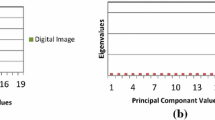Abstract
Blind noisy image estimation is useful in many visual processing systems. The challenge lies in accurately estimating the image noise level without any priori information of the image. To tackle this challenge, an iterative texture-based eigenvalue analysis approach is proposed in this paper. The proposed approach utilizes the eigenvalue analysis to mathematically derive a new noise level estimator based on weak-textured image patches. Furthermore, a new texture strength measure is proposed to adaptively select weak-textured patches from the noisy image. Experimental results are provided to demonstrate that the proposed image noise level estimation approach yields superior accuracy and stability performance to that of conventional noise level estimation approaches, so that to improve the performance of image denoising algorithm.




Similar content being viewed by others
References
Aja-Fernández S, Vegas-Sánchez-Ferrero G, Martín-Fernández M, Alberola-López C (2009) Automatic noise estimation in images using local statistics. Additive and multiplicative cases,. Image Vision Computing 27(6):756–770
Amer A, Dubois E (2005) Fast and reliable structure-oriented video noise estimation. IEEE Trans on Circuits and Systems for Video Technology 15(1):113–118
Chen L, Huang X, Tian J, Fu X (2014) Blind noisy image quality evaluation using a deformable ant colony algorithm. Opt Laser Technol 57:265–270
Dabov K, Foi A, Katkovnik V, Egiazarian K (2007) Image denoising by sparse 3D transform-domain collaborative filtering. IEEE Trans Image Process 16(8):2080–2095
Gai S, Luo L. (2013) Image denoising using normal inverse Gaussian model in quaternion wavelet domain, Multimedia Tools and Applications, pp 1–18, accepted
Huang X, Chen L, Tian J, Zhang X, Fu X (2014) Blind noisy image quality assessment using block homogeneity. Comput Electr Eng 40(3):796–807
Li B, Lin G, Chen Q, Wang H (2013) Image denoising with patch estimation and low patch-rank regularization, Multimedia Tools and Applications, accepted
Liu X, Tanaka M, Okutomi M (2013) Single-image noise level estimation for blind denoising. IEEE Trans Image Process 22(12):5226–5237
Lowe D (1999) Object recognition from local scale-invariant features. In: Proceedings IEEE International Conference on Computer Vision, Kerkyra, Greece, pp 1150–1157
Muresan D, Parks T (2003) Adaptive principal components and image denoising, In: Proceedings International Conference on Image Processing, Barcelona, Spain, pp 101–104
Pyatykh S, Hesser J, Zheng L (2013) Image noise level estimation by principal component analysis. IEEE Trans Image Process 22(2):687–699
Rank K, Lendl M, Unbehauen R (1999) Estimation of image noise variance. IEE Proceedings-Vision, Image and Signal Processing 146(2):80–84
Shin D-H, Park R-H, Yang S, Jung J-H (2005) Block-based noise estimation using adaptive Gaussian filtering. IEEE Trans Consum Electron 51(1):218–226
Tai S-C, Yang S-M (2008) A fast method for image noise estimation using Laplacian operator and adaptive edge detection, In: International Symposium on Communications, Control and Signal Processing, St. Julians, Malta, pp 1077–1081
Tian J, Chen L (2012) Image noise estimation using a variation-adaptive evolutionary approach. IEEE Signal Proc Lett 19(7):395–398
Tian J, Ma K-K (2010) Stochastic super-resolution image reconstruction. J Vis Commun Image Represent 21:232–244
Tian J, Ma K-K (2011) A survey on super-resolution imaging. SIViP 5(3):329–342
Tsai DM, Chen MC, Li WC, Chiu WY (2012) A fast regularity measure for surface defect detection. Mach Vis Appl 23(5):869–886
Zeng W, Lu X, Tan X, Tan X (2013) A local structural adaptive partial differential equation for image denoising, Multimedia Tools and Applications, accepted
Acknowledgements
This work was supported by National Natural Science Foundation of China (No. 61105010, 61375017), Program for Outstanding Young Science and Technology Innovation Teams in Higher Education Institutions of Hubei Province, China (No. T201202).
Author information
Authors and Affiliations
Corresponding author
Rights and permissions
About this article
Cite this article
Huang, X., Chen, L., Tian, J. et al. Blind image noise level estimation using texture-based eigenvalue analysis. Multimed Tools Appl 75, 2713–2724 (2016). https://doi.org/10.1007/s11042-015-2452-5
Received:
Revised:
Accepted:
Published:
Issue Date:
DOI: https://doi.org/10.1007/s11042-015-2452-5




